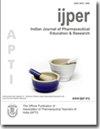白沙钻精油的化学成分及对实验性蝎子中毒后Wistar大鼠神经行为改变的治疗作用
IF 0.8
4区 医学
Q3 EDUCATION, SCIENTIFIC DISCIPLINES
Indian Journal of Pharmaceutical Education and Research
Pub Date : 2023-08-23
DOI:10.5530/ijper.57.3s.92
引用次数: 0
摘要
背景:我们的研究包括对一批被蝎子蜇伤的大鼠服用精油的化学成分的研究。与对照组相比,通过几种神经行为测试来评估神经状态,即开放分类、黑暗和光明以及强迫游泳。材料与方法:用GC/MS法测定植物精油的组成及其对大鼠接触蝎子后神经系统的保护作用。结果:GC/MS分析表明,该植物的化学组成以天然单萜类化合物紫苏醛为主,占70.12%,其次为柠檬烯(10.10%)、甲基丁香酚(5.69%)和α-蒎烯(5.04%),香芹酮(0.44%)和香樟酮(0.33%)的鉴定比例很小。与对照组和治疗组相比,这一系列测试使我们看到了被咬大鼠抑郁状态的发作,以及运动活动的显著下降。这种低运动效应伴随着动物刻板行为(好奇心、嗅觉、咬人和梳理毛发)和肌肉张力的下降,这解释了动物无法探索环境的原因。结论:神经保护能力研究证实了该植物具有改善蝎子蜇伤症状的强大特性,几项神经行为测试证明了这一点。本文章由计算机程序翻译,如有差异,请以英文原文为准。
Chemical Composition and Therapeutic Effects of Ammodicus leucotricus Essential Oils on Neurobehavioral Changes in Wistar Rats after Experimental Scorpion Envenomation
Background: Our study consists of a study of the chemical composition of the essential oil administered to a batch of rats undergoing a scorpion sting. Compared with control batches, the nervous state was evaluated by several neurobehavioral tests, namely open classified, dark and light and forced swimming. Materials and Methods: Determination of the composition of the essential oil the plant by GC/MS and its protective effect on the nervous system after exposure of rats to scorpions. Results: of GC/MS show that the chemical composition of this plant is characterized by the dominance of the natural monoterpenoid agent Perilla aldehyde, with a percentage of 70.12%, followed by Limonene (10.10%), Methyleugenol (5.69%), and alpha-Pinene (5.04%). Other compounds such as Perilla alcohol (1.90%), Beta-Pinene (0.61%), Delta-3-Carene (0.59%), Carvone (0.44%) and Camphene (0.33%) were identified only in a small proportion. The series of tests allowed us to see the onset of a depressive state, as well as a significant decrease in locomotor activity in the bitten rats compared to the controls and the treated batch. This hypolocomotor effect is accompanied by a decrease in the animal’s stereotyped behaviours (curiosity, sniffing, biting, and grooming) and muscular tone, which explains the animal’s inability to explore the environment. Conclusion: The neuroprotective power study confirmed the powerful properties of the plant to improve the symptoms caused by the scorpion sting, as proven by several neurobehavioral tests.
求助全文
通过发布文献求助,成功后即可免费获取论文全文。
去求助
来源期刊
CiteScore
1.40
自引率
0.00%
发文量
227
审稿时长
>12 weeks
期刊介绍:
The official journal of Association of Pharmaceutical Teachers of India (APTI) and is being published since 1967. IJPER, a quarterly publication devoted to publish reviews and research articles in pharmacy and the related disciplines of Pharmaceutical education. It mainly covers the articles of special interest, covering the areas of Pharmaceutical research, teaching and learning, laboratory innovations, education technology, curriculum design, examination reforms, training and other related issues. It encourages debates and discussions on the issues of vital importance to Pharmaceutical education and research. The goal of the journal is to provide the quality publications and publish most important research and review articles in the field of drug development and pharmaceutical education. It is circulated and referred by more than 6000 teachers, 40,000 students and over 1000 professionals working in Pharmaceutical industries, Regulatory departments, hospitals etc.

 求助内容:
求助内容: 应助结果提醒方式:
应助结果提醒方式:


